

![]()
BARCLAY WILLS
1877 - 1962
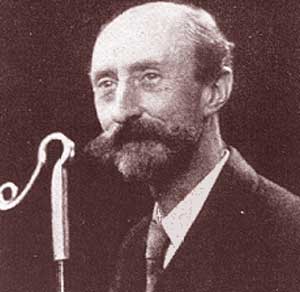
Above, Barclay Wills around 1937
(Photo from Barclay Wills' The Downland Shepherds,
edited by Shaun Payne and Richard Pailthorpe,
Alan Sutton 1989.)
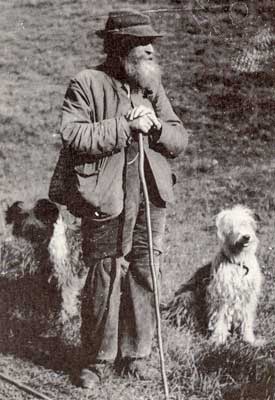 Left, a photo taken by Barclay Wills of Henry Rewell, a shepherd on Ditchling Beacon, and his two sheepdogs of the Old English-type. (Ibid.)
Left, a photo taken by Barclay Wills of Henry Rewell, a shepherd on Ditchling Beacon, and his two sheepdogs of the Old English-type. (Ibid.)
The 18th and19th centuries gave birth to naturalism, and in its wake walked many naturalists. Like W.H. Hudson before him, Barclay Wills was one of them. He was born in London and little is known about his early life. His father and paternal grandfather worked in publishing, his mother had been a clerk, and Barclay seemed to have followed in their footsteps for many years, though these positions were smothering for a young man who had a passion for wildlife from an early age. He spent his every leisure moment walking the fringes of North London and later taking trips into the countryside west of London making sketches of birds and other wildlife. In 1905 he married, and the couple had one child, a daughter. Except for her childhood years, neither his daughter nor his wife shared his passion for flora and fauna.
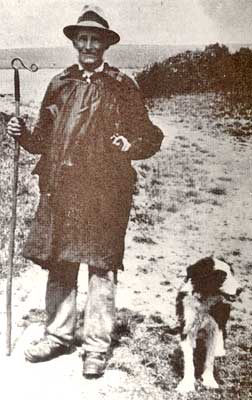 Right, another photo taken by Barclay Wills shows shepherd Walter Wooler of Pyecombe, with his "Pyecombe hook" and collie-type sheepdog. (Ibid.)
Right, another photo taken by Barclay Wills shows shepherd Walter Wooler of Pyecombe, with his "Pyecombe hook" and collie-type sheepdog. (Ibid.)
Wills was in his forties by the time he was able to move his family to Sussex near the Downs. Still, in order to make ends meet, he became a grocer and ran a succession of small shops and businesses, badly. It was up to his wife to keep things together, while he began roaming the Downs, making friends with shepherds, collecting memorabeilia of the vanishing shepherding life, and eventually writing three books about the Sussex Downs: Bypaths in Downland, Shepherds of Sussex, and Downland Treasure. He also wrote Smugglers and Smuggling in Sussex, contributed many articles to Sussex County Magazine, and was a founding member of the Society of Sussex Downsmen, which was formed to protect the Downs and its way of life.
It is the book, Shepherds of Sussex (1938) that is of major interest to us as enthusiasts of shepherd's dogs. It is filled with photographs of shepherds and their dogs, taken by Barclay Wills himself, and descriptions of shepherds often include descriptions of their dogs. Wills refers to dogs as "constant companions", to the shepherds and their dogs as "the lonely couple who work together for the good of the flock, who converse by secret signs and understand one another so well."
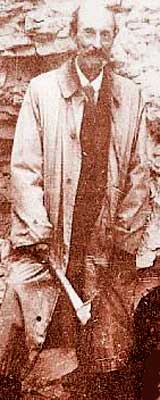 Left, Barclay Wills at an amateur archeology dig. (Photo courtesy of This is Findon Village, a website of the facinating historical record of Findon in West Sussex, maintained by Valerie Martin.)
Left, Barclay Wills at an amateur archeology dig. (Photo courtesy of This is Findon Village, a website of the facinating historical record of Findon in West Sussex, maintained by Valerie Martin.)
In his chapter entitled "The Shepherd's Companion", Wills says:
So many of us are dog lovers, and fond of our jolly companions, that we hardly realize how different is the lot of the sheep-dog to that of the ordinary pet. He (or she) is born to a life of responsible work, and shares with the shepherd the care of the flock. Like him, he works every day in the year, and his leisure is very short...
On meeting old M_____ you might think him very gruff, and to hear him shout at his dog you would be tempted to form a rather unfavourable opinion of him, yet you would be mistaken. "I do bawl at that dog," he remarked, "but he do need it, times...It don't do to let him see me laughin', but he doos some comical things. Times I bawls at him, but I laughs inside me all t'time..."
A shepherd is obliged to be particularly strict with a young dog in training, hence his impatience with people who feed a sheep-dog or bring other dogs near enough to distract the puppy's attention from the work in hand. It is usual to put a young dog to work with an older and experienced one for a time, but directly it shows an aptitude for work it should be separated from its companion and trained to obey orders alone. "It is a great mistake to leave them together too long," said one man to me, "for if 'tis done the young un is apt to expect to wait for t'other to help, and not try to work alone."
It is the careful, patient training of dogs which is responsible for the wonderful work which surprises us. Every shepherd has his own ways, and his dog is used to them, consequently we may see dogs obey signals make by a raised arm, or a motion with a crook, or respond to nods of the shepherd's head, movements of his eyes, whistles, calls, muttered words, and other half-secret signs....
Some shepherds show a preference for bob-tails or similar rough-haired dogs, others for collies. Both kinds are seen at sheep sales, chained to pens or wheels or other convenient places....
Collies used for sheep-dogs are often unsafe for strangers to handle, but Prince was an exception to the rule. when I met Shepherd Newell near the Devil's Dyke he had a fine collie for a companion. Newell's flock was usually penned for the dinner hour in an enclosure near the Dyke Hotel, consequently Prince found many friends. It was only natural that constant attentions from visitors make him "soft" from the shepher's point of view, but his master, a dear, quiet old man, smiled indulgently when ladies exclaimed: "Oh, what a beautiful dog!" and fed him with dainties of all kinds. "He gets plenty of nice chocolates and things given tohim," said Newell, "but the ladies don't think to say: 'Will shepherd have one?'"
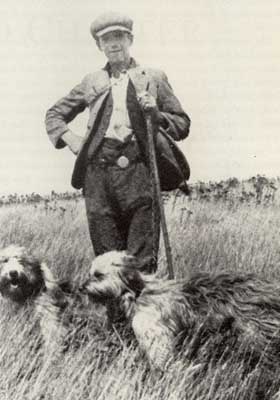 Right, a photo of a young shepherd, John Beecher, with his two rough-coated dogs, taken by Barclay Wills, who made it his business to photograph all the shepherds he came across. [To me, these dogs resemble the Bearded Collie more than the Old English Sheepdog. I welcome comments on this. --ed.]
Right, a photo of a young shepherd, John Beecher, with his two rough-coated dogs, taken by Barclay Wills, who made it his business to photograph all the shepherds he came across. [To me, these dogs resemble the Bearded Collie more than the Old English Sheepdog. I welcome comments on this. --ed.]
Wills respected both shepherd and dog, and was, as a naturalist, a keen observer. So, although it may appear that he may not have gotten the relationship between shepherd and dog right, especially when it came to training (by today's standards), we can rest assured that his perceptions were correct. Here he describes the actions of a dog that has just driven his master's flock to a dewpond for watering:
It is a pleasant sight to watch the arrival of a thirsty flock. In a few seconds the peaceful solitude of the pond is transformed. Its edge is thronged with eager animals, and the noses of the first few disturb the surface of the mirror. Without a pause the crowd encircles the pond. The old bells on the ewes have their edges immersed while their owners take the welcome drink. After much pushing the noisy crowd are satisfied. Slowly they move away.
The dog watches his master's face for the signal to refresh himself. It is given and he leaps to the pond edge and laps vigorously. His feet and legs are wetted and his face well washed. He somehow gives you the idea that he could enjoy much more if only he could spare the time. He stays on the bank just long enough to give his head and feet a quick shake, then stands at attention. The shepherd raises his arm. Instantly the wonderful dog obeys the instruction. The sheep have not had time to stray far and are soon rounded up and gently turned towards the track leading to their next feeding ground.
Wills mentions above that some shepherds preferred collies, while others preferred the Old English-type of sheepdog. Here he elaborates on that:
In 1989, a book came out (Barclay Wills' The Downland Shepherds, Alan Sutton Publishing) which contains many of the best parts of all three of Wills' books on Sussex. It is a beautiful volume, incorporating most of Wills' photographs with paintings by English artist Gordon Beningfield and many contemporary photographs. In it, the editors (Shaun Payne and Richard Pailthorpe) note that "Shepherds would invariably breed their own [dogs] and keep an Old English Bobtail dog for fold work and a collie for Downland work. During the 1920s a good pup cost £2. There was also a distant[ly related] breed of Sussex sheep dog, smaller than the Old English and brown in colour."My reference to the two dogs in the fold led the shepherd to chat about them. He prefers bob-tails or rough-haired dogs to collies as he has found them better for work. He said that where the feeding-ground is bordered by crops, a bob-tail will watch and see that the sheep do not intrude over the border line, but he has not found that collies do this so well. Bob-tails may feel the heat as much as most dogs, but they disregard cold and wet and work through it, whereas a collie will endeavour to take shelter from drenching rain under the shepherd's big coat or some other cover.
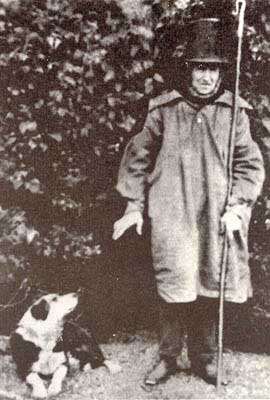 Barclay Wills was an avid collector of artifacts of a vanishing culture: sheep bells were of particular interest, Pyecombe hooks (crooks), smocks, shears, horn lanterns, etc. (His collection is now housed in the Worthing Museum and Art Gallery). But he was also keenly aware that part of the culture had already disappeared. His interviews with shepherds who were in their 60s, 70s, 80s, and the detailed notes he wrote after such interviews, allowed him to record that history while those men whose parents and grandparents lived it were still alive. The photo at left is of the grandfather of one of "his shepherds", taken about 1860. Wills thought it might have been one of the earliest photographs taken of a shepherd and his dog. He had borrowed it from the owner for his book. It shows the shepherd wearing a smock and tall hat that was the costume of the day and holding his Pyecombe hook. Interestingly enough, the dog is a collie rather than a "bob-tail", which seems to indicate that collies had not just moved in on "bob-tail territory" at the turn of the 20th century. In fact, here is an elderly shepherd from the mid-19th century with the "newer" breed of dog (in the area), while the photo above right shows a young, early-to-mid-20th century shepherd with the "older" breed of dog.
Barclay Wills was an avid collector of artifacts of a vanishing culture: sheep bells were of particular interest, Pyecombe hooks (crooks), smocks, shears, horn lanterns, etc. (His collection is now housed in the Worthing Museum and Art Gallery). But he was also keenly aware that part of the culture had already disappeared. His interviews with shepherds who were in their 60s, 70s, 80s, and the detailed notes he wrote after such interviews, allowed him to record that history while those men whose parents and grandparents lived it were still alive. The photo at left is of the grandfather of one of "his shepherds", taken about 1860. Wills thought it might have been one of the earliest photographs taken of a shepherd and his dog. He had borrowed it from the owner for his book. It shows the shepherd wearing a smock and tall hat that was the costume of the day and holding his Pyecombe hook. Interestingly enough, the dog is a collie rather than a "bob-tail", which seems to indicate that collies had not just moved in on "bob-tail territory" at the turn of the 20th century. In fact, here is an elderly shepherd from the mid-19th century with the "newer" breed of dog (in the area), while the photo above right shows a young, early-to-mid-20th century shepherd with the "older" breed of dog.
You may be lucky enough to obtain an original edition of Shepherds of Sussex which is not easily come by and is expensive when it is. If not, the 1989 Barclay Wills' The Downland Shepherds is readily available online, and there is also a paperback edition published in 1991.
One more thing: Barclay Wills mentions in his book that there was a sheep-wash located in Fulking, West Sussex, next to a 17th century inn called The Shepherd & Dog, where the shepherds would repair when sheep washing was over. Many aspects of the culture are dead and gone, but it may be comforting to know that this pub still exists.
Copyright 2008 by Carole L. Presberg
THE OTHER WEB PAGES WE MAINTAIN
These web pages are copyright ©2013
and maintained by webmeistress Carole Presberg
with technical help from webwizard David Presberg
ALL RIGHTS RESERVED
If you are interested in using ANY material on this website, you MUST first ask for permission.